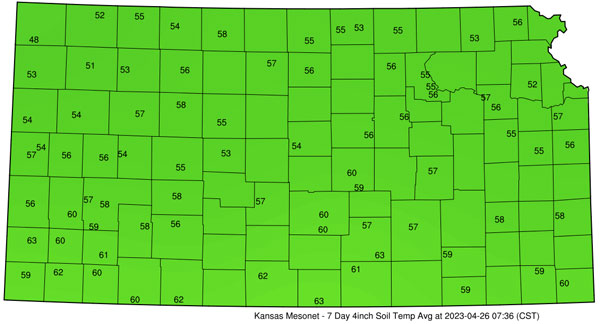Warm soil temperatures for the last couple of weeks in Kansas means that corn planting is well underway. As of April 24, approximately 24% of corn acres have been planted in Kansas, ahead of the five-year average of 19% (USDA NASS), with approximately 3% emerged. The planted area for soybeans is still below 5% but ahead of the historical average of 1% with no emerged soybean plants registered yet. However, temperatures for the week of April 23 plummeted below freezing with durations of several hours in many locations across Kansas, particularly the last weekend (Figure 1). What does this drop in temperature mean for newly planted corn?

Figure 1. Accumulated hours of air temperature below 32°F from April 22 to April 23, 2023. Map from Kansas Mesonet.
For this week (April 16-22), the average soil temperature at both 2 inches and 4 inches ranged from 48°F in northwest Kansas to 64°F in the south central region (Figure 2).


Figure 2. Average soil temperatures at 2-inch (upper panel) and 4-inch (lower panel) soil depth for the week of April 20 - 26, 2023. Maps from Kansas Mesonet.
Daily soil temperature variation within the last week (7-day report) was recorded across Kansas for several locations (Figure 3), presenting variations around 20°F. Overall, cooling conditions have been observed statewide after the very warm start to the month. Where precipitation has occurred, temperatures have become much steadier. Some marginal increases in the last week have been observed in the northeast as moisture has missed that region with drying conditions (Figure 3).

Figure 3. 7-day soil temperatures (2- and 4-inch soil depth) for Hiawatha, Parsons, Mitchell, Hutchinson, Colby and Garden City (top left to bottom right). 2-inch depth represented by yellow line; 4-inch depth represented by orange line. Graphs produced by the Kansas Mesonet.
Chilling injury in corn
Cold temperatures can result in injury to the germinating seed as it is absorbing moisture – a problem called imbibitional chilling injury. Germinating seeds can be damaged when soil temperatures remain at or below 50 degrees F after planting.
Soil temperatures at the 4-inch depth during the first 24-72 hours after planting are critical. It is during this window that the kernels imbibe water and begin the germination process. Kernels naturally swell when hydrating – taking in water. If the cell tissues of the kernel are too cold, they become less elastic and may rupture during the swelling process, resulting in “leaky” cells. Injury symptoms may include swollen kernels that fail to germinate or aborted growth of the radicle and/or coleoptile after germination has begun.
Chilling injury can also occur following germination as the seedlings enter the emergence process. Chilling injury to seedlings can result in:
- Reduced plant metabolism and vigor, potentially causing stunting or death of the seminal roots
- Deformed elongation (“corkscrewing”) of the mesocotyl
- Leaf burn (Figure 4)
- Delayed or complete failure of emergence, often leafing out underground
Chilled seedlings may also be more sensitive to herbicides and seedling blights.

Figure 4. Leaf burn from freeze damage early after corn emergence. Photo by Ignacio Ciampitti, K-State Research and Extension.
Impact of cold on soybeans
For this crop, a similar impact could be expected but depending on the planting time and overall plant growth. The most susceptible stage is as the plants are emerging (recently planted). The most typical sign of the impact of freezing temperatures on soybeans can be visualized in the stem and mainly with the yellowing of the cotyledons. If soybeans were advanced in growth, with unifoliate, then the overall impact of a freeze on the cotyledons will be very minor, with most likely no yield loss. If there is a large impact on cotyledons (without having unifoliate leaves unfolded), then there is a lower chance for those soybeans plants to survive.
For some of the fields scouted in the last days, most of the damage is cosmetic and even when some yellowing was present in cotyledons, this effect is minor and most likely will not produce any impact on yields.
Producers should consider all these factors when deciding on the planting time. Before making any decisions, fields should be scouted 4-7 days after the cold occurred as the extent of the damage and potential for new growth will be evident during this time. More information about the planting status of summer row crops will be provided in upcoming issues of the Agronomy eUpdate. Stay tuned!
Ignacio Ciampitti, Farming Systems
ciampitti@ksu.edu
Adrian Correndo, Postdoctoral Fellow
correndo@ksu.edu
Christopher “Chip” Redmond, Kansas Mesonet Network Manager
christopherredomond@ksu.edu
Tags: soybeans corn freeze injury chilling injury cold soils